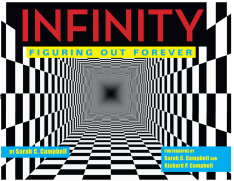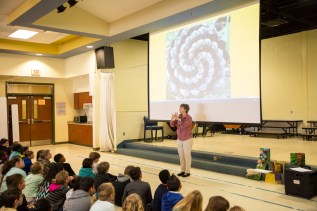
Welcome to STEM Tuesday: Author Interview, a repeating feature for the last Tuesday of every month. Go Science-Tech-Engineering-Math!
Today we’re interviewing Sarah and Richard Campbell, creators of Infinity: Figuring out Forever by Astra Young Readers.

This picture book is a fascinating look at the concept of infinity told in a way that resonates with young children. The Booklist review said, “….the authors take a complex abstraction and make it accessible to young readers through non-technical descriptions, relatable examples, and full color, original photos that effectively reinforce the text..”
Bank Street Cook Prize Silver Medalist
Bank Street Best Book of the Year
Eureka! Nonfiction Silver Honor Award (California Reading Association)
Finalist, Bank Street College of Education Cook Prize
Texas Library Association Texas Topaz Nonfiction Reading List
* * *
Christine Taylor-Butler: Before we get to your books, tell our readers a little about yourself:
Sarah Campbell: I was as journalist so I went to journalism school. I graduated from Northwestern and then got a Rhodes Scholarship to study in Oxford. I met Nelson who was ahead of me. When he graduated, he got a job in London while I finished my degree. After that he uprooted himself to move with me to Mississippi.
I worked for daily newspapers. Then stepped away from that when I had children. They’re grown now. My oldest, Graeme went to MIT and married an MIT grad. He’s a computer scientist. My middle child, Nathan, is the catalyst behind Nathan’s Pet Snails for Highlights. He just defended his PhD but credits that work for his success. My youngest son, Douglas, is a software engineer.
Richard Campbell: I’m Chief Financial Officer at a community development financial organization
CTB: How did you get into writing books for children?
Sarah: I wanted to continue to write, then found myself reading children’s books. I had 3 boys and this would allow me to keep writing but be involved with how my boys were learning about the world.

I wrote about a predatory snail my son found in the backyard. Highlights asked if I would do a book on it. It took about 6 years to get the article to come out. But the book was out in about a year. It was a Theodore Seuss Geisel honor winner. So the publisher decided to do the Fibonacci book, then the Fractal book. The idea for Infinity came from the team, and I was reluctant because of the issues around finding the illustrations.
The photographs are really a huge part of what I do as a creator. There were certain children’s literature classes about how the pictures and words can’t stand alone. It’s not a simple matter of write a text and find stock images. It’s a marriage of the two. In the conceiving of the idea, you have to have both in mind.


Christine: I really appreciate that Richard is so involved despite having a full-time job. Richard, how do you fit in the time to do your photographs and web design?
Richard: I’m a little bit of a tech geek. So the web design stuff were things I enjoyed playing with. On the photograph stuff, it was stuff they both enjoyed doing. Sarah would say, “we have to get the photographs done this weekend,” as she was working on the book. And there are many photos that didn’t make it into the book. We spent a whole weekend on a melon getting cut up, or an orange.
We drove up to find parallel lines. One weekend, we got up at the golden hour (sunrise). There’s an app called The Photographers Ephemeris which will tell you when the sun will rise anywhere in the world. I would find the straightest road in the middle of nowhere and use the ephemeris to find out when the sun would be rising. We chose Highway 61, north of Hollandale, Mississippi.
 One Saturday we got up at 4 in the morning and it was about 90 minute drive. We took a stepladder with us. There was not much traffic, but there was some. We put the stepladder in the middle of the road, then a car would come down and I’d have to climb down. I wanted to get as clear as possible. I was waiting for the cars to stop. and Sarah would yell “There’s a truck coming!”
One Saturday we got up at 4 in the morning and it was about 90 minute drive. We took a stepladder with us. There was not much traffic, but there was some. We put the stepladder in the middle of the road, then a car would come down and I’d have to climb down. I wanted to get as clear as possible. I was waiting for the cars to stop. and Sarah would yell “There’s a truck coming!”
Sarah: We made sure the photographs got done that weekend. One of the things that was really nice – he could schedule a job
CTB: Infinity was written for younger children. Was it difficult writing something so short?
Sarah: Some of the concepts in the main text had to be shifted to back matter. The back matter is a great way to extend the audience and that’s a place to put the enrichment. Writing about Infinity for the youngest readers is driving home the concept of “always one more.” It was tricky. We didn’t count the number of drafts we went through to nail the concept.
“Thinking about infinity is fascinating.
Send your brain in search of something that never ends.
See what comes to mind.”
One of my positions is that I’m not a mathematician. Some writers come at this as STEM and people assume I’m STEM too. But despite not having a math degree I had a really strong curiosity about math. I took calculus in college but it wasn’t my passion. Even so, because I’m so interested, I’ll read about it. I have a big bookshelf about math, infinity, patterns. So I have a drive, but it doesn’t come easily or naturally. My journalism background helps me explain it to a layperson: skills to read the books and dealing with a difficult concept and then finding a way in for a young reader.

CTB: So you’re not writing rhyming books or poetry.
Sarah: No. One of my commitments was that my books also be about math. Something a mathematician would recognize. I wanted to tickle the intellect and advance the conversation about patterns and math.

Students at Casey Elementary working on fractals.
For example, I can use the fractal book (Mysterious Patterns) to talk about a particular kind of shape at different scales. But when do we learn about the most basic shapes? We learn about circles and squares, cubes and cones. I was able to say, at the most basic level, that a fractal is a shape. I’m trying to find the prior knowledge a kid has to start explaining this new concept.
Kids love infinity and they think it must be something really really big. But the idea of having one more is not always about something being unlimited. I also handle the idea of, “it’s just beyond.” If you make infinite takeaways, for example, slicing the orange in the book.
Infinity was fun, but a lot of hard work. The idea of thinking about the things that kids think about when exploring infinity. I would say, “How would you photograph infinity?” and kids would talk about faith and stars.
CTB: Sometimes you create videos to go with your books.
Sarah: Yes, if you want to know about how we came up with the ideas for Infinity, we created an acceptance video for the 2023 Cook Prize awards because of Covid. The video handles a lot of the questions around how we settled on specific photographs. We took many that didn’t work and we explain why:
Click here for 2023 Cook Prize awards video
If you would like to learn about fibonacci numbers, try this trailer:
https://sarahccampbell.com/video-growing-patterns-book-trailer
CTB: What are you doing now?
Sarah: I went back to full-time work 4-1/2 years ago. I’m not finding the same time to write. But this job has other rewards. I am now Deputy Director of Programs and Communication at the Mississippi Departmet of Archives and History. The department oversees the Mississippi Civil Rights Museum and the Museum of Mississippi History as well as other historic sites. It’s fun. There’s a lot of learning that goes into a new job and content area. I thought I knew the history of Mississippi but now it’s a crash course on the colonial period, the reconstruction era, etc.
I’m waiting for the muse to strike for my next book. I’m a little more realistic about my time now that I’m working. But if I’m struck by the right idea, I could see doing another book.
“Defining infinity is difficult.
But there is one thing people do every day that leads to infinity—counting.
No matter what large number you name, there is always a larger number.”


Sarah C. Campbell is an award-winning author and photo-illustrator. Her critically-acclaimed first book, Wolfsnail: A Backyard Predator (Boyds Mills Press), was named a 2009 Theodor Seuss Geisel Honor Book and made the Cooperative Children’s Book Center’s 2009 Choices List. Her newest book, Growing Patterns: Fibonacci Numbers in Nature, was published in March 2010. Her writing and photographs have appeared in numerous publications, including The New York Times, Highlights for Children, and Highlights’ High Five. Visit www.sarahccampbell.com

Richard P. Campbell is co-photographer with his wife Sarah C. Campbell of the acclaimed children’s nonfiction books Wolfsnail, Growing Patterns, and Mysterious Patterns, as well as the photographer of some of the photos in Infinity. During the day, Richard is chief financial officer for Gulf Coast Housing Partnership.
—–

Your host is Christine Taylor-Butler, a graduate of MIT and author of The Oasis, Save the… Tigers, Save the . . . Blue Whales, and many other nonfiction books for kids. She is also the author of the STEM based middle grade sci-fi series The Lost Tribes. Follow @ChristineTB on Twitter and or @ChristineTaylorButler on Instagram. She lives in Missouri with a tank of fish and cats that think they are dogs.





 Amazing Allies: 15 Amazing Women in Wildlife Research
Amazing Allies: 15 Amazing Women in Wildlife Research It Takes Guts: How Your Body Turns Food Into Fuel (and Poop)
It Takes Guts: How Your Body Turns Food Into Fuel (and Poop) The Secret Science of Sports: The Math, Physics, and Mechanical Engineering Behind Every Grand Slam, Triple Axel, and Penalty Kick
The Secret Science of Sports: The Math, Physics, and Mechanical Engineering Behind Every Grand Slam, Triple Axel, and Penalty Kick 








